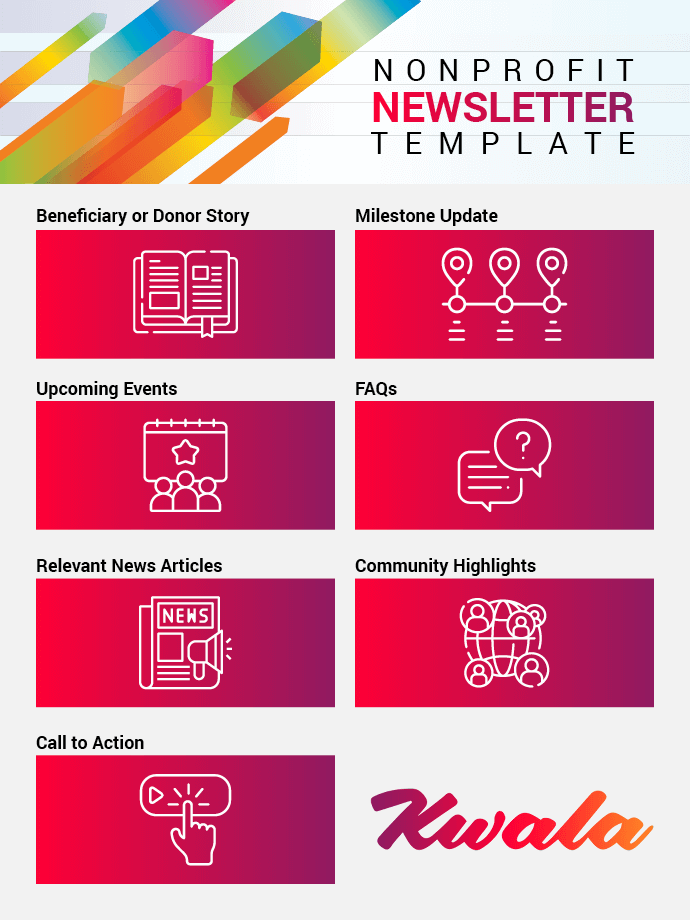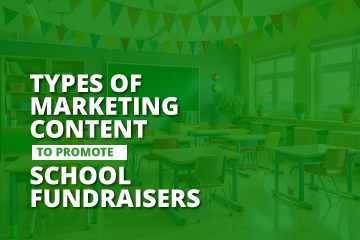Promoting Your School’s Fundraisers Online: 4 Strategies
While every school’s community is unique, it’s fair to assume that a significant portion of your audience gets their news online. In many ways, digital marketing is actually easier than traditional communications. Rather than printing out flyers and hoping students bring them home to their families intact, you can reach out to parents directly and continually throughout your entire fundraiser.
To help you launch your fundraiser’s online marketing campaign, we’ll explore four strategies almost any school can implement.
1. Design an events page for your website.
Think of your website as the foundation for your online outreach. Whenever a potential supporter gets an email about your event or sees a post on social media, they should be able to navigate to your website to find out more. This means you first need to create a place on your website where supporters can learn more.
When designing your fundraising and events page on your website, include these elements:
- A fundraising calendar. If your school has multiple fundraisers and events throughout the year, create a virtual calendar on your website that supporters can click through. This helps them visualize when events are happening and plan ahead if they see an opportunity they want to get involved in. For instance, if you put your holiday fundraisers on the calendar right at the beginning of the school year, parents can clear their schedules months in advance so they’re prepared to participate.
- Event details. Provide information about what each of your fundraisers entails. This includes what activities your community can participate in, how the fundraiser supports your school, and where and when it takes place.
- Registration or donation form. For events, include a registration form so interested visitors can sign up immediately from your website. For other types of fundraisers, have your donation, checkout, or other revenue-collecting pages ready for supporters interested in making a contribution.
You don’t need to be a website design expert to build an effective events page. Use templates and ready-made widgets to insert the elements you need, keep the page design simple, and make sure its branding matches the rest of your website.
2. Create a digital newsletter.
Encourage students’ parents and other interested family members to sign up for your digital newsletter at the beginning of the school year. Your digital newsletters can be sent out on a weekly, monthly, or even quarterly basis depending on how much your school has to share with your community.
Your newsletter keeps your community in the loop and is an easy way to promote and remind supporters about upcoming fundraisers. To get started designing your newsletter, take a look at this nonprofit newsletter template from Kwala:

While designed for nonprofit organizations in general, this template can easily be adapted to schools. Some of the changes you might make include:
- Sharing student and staff stories instead of donors. Donors are still important to your school, but parents are more likely to open a digital newsletter if there’s a chance their smiling students will be featured in it. Highlight student clubs, staff accomplishments, and anything else fun and exciting happening at your school that parents might want to know about.
- Removing milestone updates. Unless your school is undergoing a major construction project or launching a brand-new curriculum, you likely don’t have milestones to share with your community.
- Expanding the event and fundraiser section. Ultimately, templates are just suggestions, so play around with giving certain sections more space as needed. If you have a fundraiser to highlight, move it to the top of your newsletter and give it as much space as it needs!
Additionally, newsletters are a place to provide little tips and reminders to your community. For example, you might regularly highlight that supporters can give more to your fundraisers by tapping into their workplace giving programs.
3. Get your students involved.
One of your school’s biggest assets for promoting fundraisers is your students. Your students are likely digitally savvy, and with the right encouragement, can help promote your fundraisers to their family and friends online.
First, consider what fundraising ideas for schools will get your students excited. Will they be willing to promote the items they’re selling as part of a product fundraiser on Instagram? Or would they be happier just being asked to help market an event by making short videos?
One way you can get students invested is by gamifying participation. Gamification is the practice of adding game-like elements to an activity, such as a leaderboard, prizes, or even just sound effects and animations.
Fortunately, various social media platforms already have built-in fundraising methods that leverage gamification strategies, like Facebook Challenges. The marketing experts at Getting Attention helpfully provide this explanation of what Facebook Challenges are and how they work: “In a Facebook Challenge, nonprofits challenge Facebook users to complete an activity and post their progress or results on social media. The activities are launched to raise awareness and donations for a nonprofit’s cause.”
The challenge itself can be anything, from creating the best dance to recording a “try not to laugh video” to trying spicy foods. For a school challenge, pick something that students will want to participate in but also has an educational or developmental bonus, like an exercise challenge.
These types of challenges can also be done on social media sites other than Facebook, like Instagram or TikTok. For young students, make sure they have their parents’ permission or even advise them to post on their parents’ accounts. That way, the parents can control comments, and students who aren’t old enough to create social media accounts can still participate.
4. Keep marketing until the fundraiser ends.
The best time to start marketing a fundraiser varies. For most fundraisers, your school should start promoting them a week or two in advance at minimum, although earlier is better in many cases. The best time to stop marketing for a fundraiser is when the fundraiser is over.
For example, say your school is hosting an online auction. You promote prizes far in advance to encourage registrations for the multi-day event. Then, you continue making posts about the state of your auction, high-value items with low bids, and exciting ongoing bidding wars all the way up until your auction closes, when you create one last post to thank participants.
Continual marketing, especially for fundraisers that last several days, encourages late participants to jump in and current ones to keep going and continue supporting your school.
Digital marketing lets your school connect with parents at any time, anywhere. Help them discover your school’s fundraisers and plan their involvement far in advance by promoting your events online and providing continual reminders all the way up until your fundraisers’ closing. Last thank your supporters for all the ways they contributed during your fundraiser to get them coming back for your next one!



